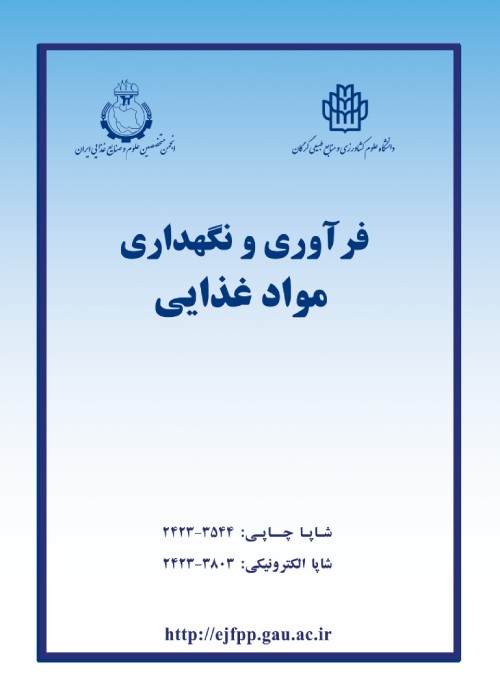Impact of Animal Lipase Enzymes on Development of Lipolysis in Iranian-White Brined Cheese during Cold Storage
Author(s):
Article Type:
Research/Original Article (دارای رتبه معتبر)
Abstract:
Background and objectives
Cheese ripening is a complicated process that involves the breakdown of the cheese compounds via proteolysis, lipolysis and other enzyme catalysis which cause typical changes in cheese flavour characteristics. Lipolysis is one of the most biochemical reactions in cheese that through formation of short- and middle-chain fatty acids and finally convert them to flavour compounds such as methyl ketones, lactones, secondary alcohols, aldehydes and thioesters, plays an important role in cheese flavour and it also accelerate cheese ripening. Consequently, to increase cheese lipolysis in some cheese varieties, commercial lipases (with animal and microbial origins) is used. However, excessive levels of lipolysis may cause undesirable effect in cheese flavour and result in cheese rancidity. There is scarce investigation regarding to application of lipase enzymes (particularly animal lipases) in white brined cheese. Therefore, this research was performed to evaluate the effect of calf and kid goat lipases on development of lipolysis in Iranian-white brined cheese and to determine the best kind (calf or kid goat lipase) and appropriate level of enzyme to produce a cheese with an acceptable quality.Materials and methods
In this research, Iranian-white brined cheese samples were produced from fresh cow milk via enzymatic (rennet cheese) procedure according to conventional method of cheese making in Iran. After standardization of milk fat to 3%, homogenization and pasteurization, the milk was cold to 35 ˚C and the calf or kid goat lipases at levels of 0 (control sample), 1.5, 3, 4.5 and 6 g/100 Kg of milk before renneting stage were added to the milk. The extent of free fatty acids/lipolysis (acid value, AV) and sensory scores (odour, colour, taste and texture) of Iranian-white brined cheese samples were measured during 90 days of the storage (1, 7, 14 and 21 days) at refrigerator and free fatty acid profile (FAP) analysis and microstructure assessment of cheese samples were measured at the end of 90 days of the cold storage. Analysis of fatty acid composition was carried out by gas chromatography with flame ionization detector. Results
The results showed that increasing the amount of lipase concentrations and storage time significantly caused an increase in cheese lipolysis (p<0.01). Even though kid goat lipase introduced more changes in the experimental parameters like fatty acid profile and ADV, the kind of lipases had no significant effect on sensory attributes of the cheese samples (p>0.05). Furthermore, based on FAP results, though an increase in enzyme concentration produced a higher low-, medium-, long-chain and total free fatty acids (TFFA) (p<0.01), this increase was more obvious for low-chain fatty acids. Among different treatments, control sample with 132.91 g/100 Kg TFFA had the lowest and cheese sample containing 6 g kid goat lipase with 309.51 g/100 Kg had the highest TFFA at end of the 90-day storage period. Sensory evaluation also showed that samples having lipase enzymes had a higher mean sensory scores for odour, taste and texture when compared with control (without lipase enzyme) (p<0.001). Microstructure results of white brined cheese samples showed that by enzymatic treatment, an extensive lipolysis was occurred which subsequently caused a significant reduction in number and size of fat globules in the cheese structure. These changes due to formation of new cross-linkages between caseins and casein network rearrangement, result in a condensed texture and an increase in cheese hardness.Conclusion
According to the results, by using 4.5 g lipase enzyme (kid goat or calf, per 100 Kg of milk), a white brined cheese with improved sensory characteristics could be produced. Based on sensory results, no significant difference were found between two lipase enzymes, i.e. kid goat or calf lipases.Keywords:
Language:
Persian
Published:
Electronic Journal of Food Processing and Preservation, Volume:14 Issue: 4, 2023
Pages:
37 to 54
magiran.com/p2567758
دانلود و مطالعه متن این مقاله با یکی از روشهای زیر امکان پذیر است:
اشتراک شخصی
با عضویت و پرداخت آنلاین حق اشتراک یکساله به مبلغ 1,390,000ريال میتوانید 70 عنوان مطلب دانلود کنید!
اشتراک سازمانی
به کتابخانه دانشگاه یا محل کار خود پیشنهاد کنید تا اشتراک سازمانی این پایگاه را برای دسترسی نامحدود همه کاربران به متن مطالب تهیه نمایند!
توجه!
- حق عضویت دریافتی صرف حمایت از نشریات عضو و نگهداری، تکمیل و توسعه مگیران میشود.
- پرداخت حق اشتراک و دانلود مقالات اجازه بازنشر آن در سایر رسانههای چاپی و دیجیتال را به کاربر نمیدهد.
In order to view content subscription is required
Personal subscription
Subscribe magiran.com for 70 € euros via PayPal and download 70 articles during a year.
Organization subscription
Please contact us to subscribe your university or library for unlimited access!


